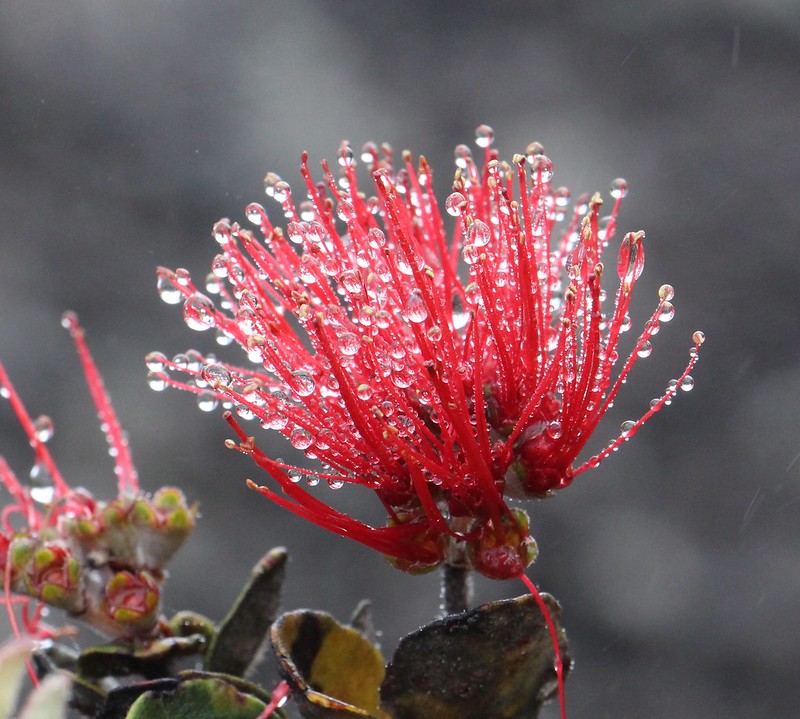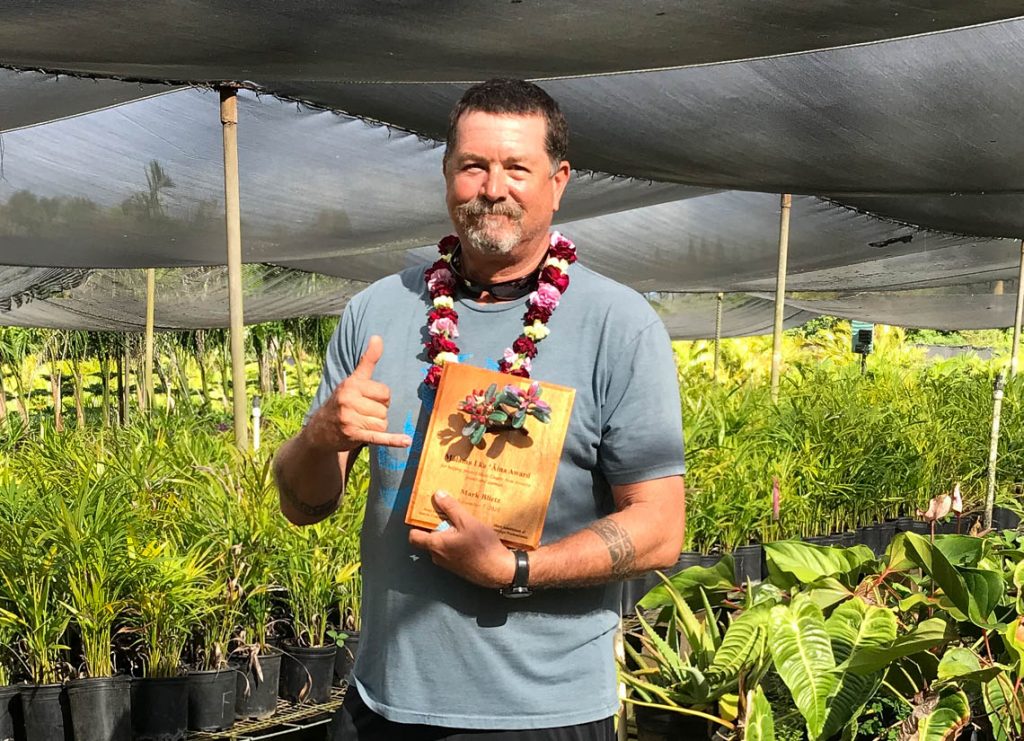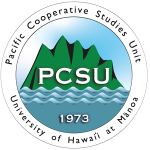ʻŌhiʻa are the pioneers – the first trees to grow on bare lava. ʻŌhiʻa are also adaptable – they grow from sea level to tree line. ʻŌhiʻa are critical in capturing fresh water, supporting threatened and endangered species, and maintaining traditional cultural practices like hula. But these remarkable trees are at risk from Rapid ʻŌhiʻa Death (ROD), a disease that kills ʻōhiʻa trees. ROD has killed over one million ʻōhiʻa across Hawaiʻi Island. Diseased trees have been found on Kauaʻi, Oʻahu, and Maui. Already, hula hālau are staying out of the forests to protect ʻōhiʻa.
Since 2014, a team of highly dedicated scientists – ecologists, plant pathologists, geographers, and foresters – have been studying the origin, impact, and spread of the two newly identified species of fungus that cause Rapid ʻŌhiʻa Death (ROD): Ceratocystis lukuohia and Ceratocystis huliohia. Ceratocystis is a common – and sometimes devastating – plant pathogen, but these two species of Ceratocystis are new to science and new to Hawaiʻi.
Researchers Flint Hughes of the USDA Forest Service, Ryan Perroy of UH Hilo, Greg Asner of Arizona State, and others are using a combination of remote-sensing and field observations to gauge ʻōhiʻa death across Hawaiʻi Island. They have found that more trees are killed by ROD in areas where non-native hooved animals are present when compared to areas protected from those animals.
Invasive animals wound the bark of ʻōhiʻa, creating an entry point for the fungus. Damage from goats, sheep, and cattle is obvious – bark is missing. But the team also observed higher numbers of ROD-killed trees in forests with high pig populations. It is possible that pigs are damaging the roots of the trees opening it up for infection.
In a greenhouse study, pathologist Marc Hughes of the University of Hawaiʻi and the USDA Forest Service mulched potted ʻōhiʻa seedlings with sawdust made from infected trees containing Ceratocystis. The trees were healthy until Hughes cut some of the roots with a knife. Those trees then died, indicating that injuries to roots can also create opportunities for the fungus to infect trees.
“Wounds can only be infected for a short time. Once they dry out the fungus can no longer infect them. So protecting a forest helps, even if it has some ROD now” says J. B. Friday, extension forester with the University of Hawaiʻi Cooperative Extension Service.
Protecting the forests also helps ensure seedling survival. Ecologist Stephanie Yelenik of the USGS conducted experiments looking at what happens to ʻōhiʻa seedlings under ROD-affected trees, in plots where invasive plants and animals were removed and in plots where the pests remained. As seedlings died, researchers tested them for the presence of ROD – no sign of the pathogen was present. Seedlings were six times more likely to die in plots where invasive species were left unchecked. Invasive plants and animals posed a greater threat to the seedlings than ROD did during the study.
The first step in addressing ROD on Maui is to prevent it from arriving. HDOA has established a quarantine on the movement of ʻōhiʻa trees and plant parts from Hawaiʻi Island to other areas in the state. Hikers should brush off soil and clean boots or shoes with rubbing alcohol to remove any ROD-contaminated soil when traveling between islands.
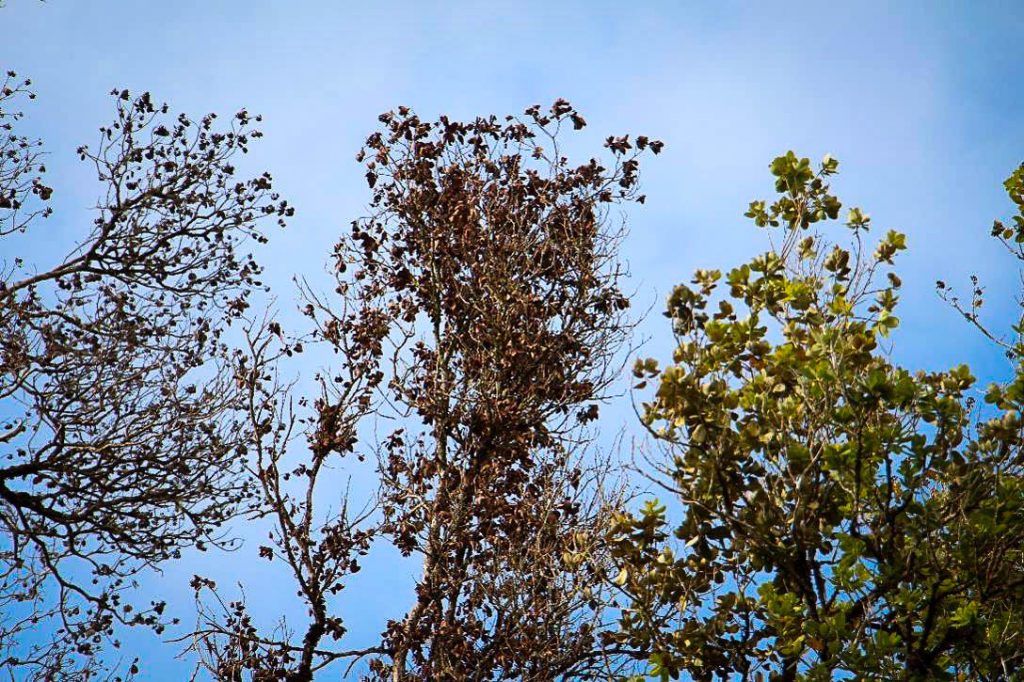
Indiciations of ROD infection include a branch or tree dying quickly – within weeks. 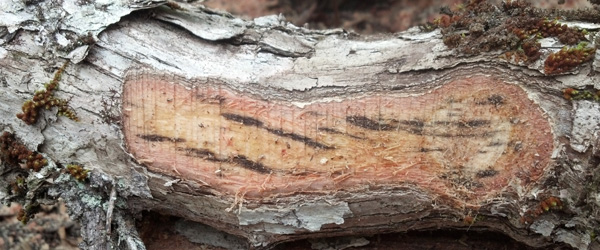
The Ceratocytis fungus responsible for killing ʻōhiʻa across 15,000 acres on Hawaii Island can be seen as a dark staining in the sapwood. Photo by J.B. Friday 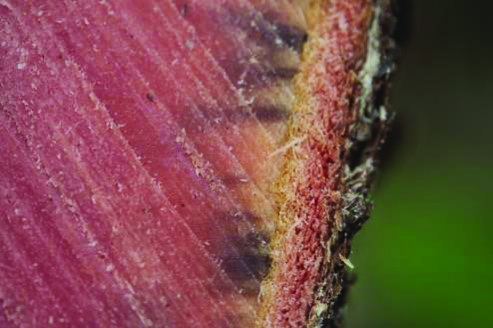
The Ceratocytis fungus spreads throughout the sapwood or vascular system of the ʻōhiʻa, eventually strangling the tree. The dark staining in this cross-section of an ohia is a symptom of infection by the Ceratocytis fungus. Photo by J.B. Friday
Early detection, finding trees affected with ROD before the disease is widespread, is also key to protecting our ʻōhiʻa. Key signs include leaves that rapidly turning brown and appear frozen in place. On Maui, the only known ROD-affected tree was reported by an alert resident in Hāna. The tree has since been destroyed. The Hawaiʻi Department of Land and Natural Resources surveys our ʻōhiʻa forests looking for symptomatic trees. Conservation crews and Maui residents can report ʻōhiʻa trees that appear to have died quickly. To date, residents have reported fourteen suspect trees over the last year. Though ʻōhiʻa die for many reasons, including drought, injuries from mowers or yard equipment, and herbicide, reporting is essential to finding ROD-damaged trees early. Fortunately, aside from the one tree, all other samples collected from Maui have tested negative for ROD.
Help protect our ʻōhiʻa forests from rapid ʻōhiʻa death: Support watershed protection efforts to remove invasive plants and animals. Respect the inter-island quarantine. Keep reporting suspect ʻōhiʻa trees on Maui to MISC (573-6472) or through 643PEST.org. Join the ʻŌhiʻa Love Festival, November 16-21st. Sign up for the virtual event through rapidohiadeath.org.
Lissa Strohecker is the public relations and education specialist for the Maui Invasive Species Committee. She holds a biological sciences degree from Montana State University. Kia’i Moku, “Guarding the Island,” is prepared by the Maui Invasive Species Committee to provide information on protecting the island from invasive plants and animals that can threaten the island’s environment, economy, and quality of life.
This article was originally published in the Maui News on November 10, 2020 as part of the Kia‘i Moku Column from the Maui Invasive Species Committee.
Read more Kiaʻi Moku articles



